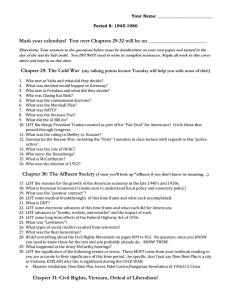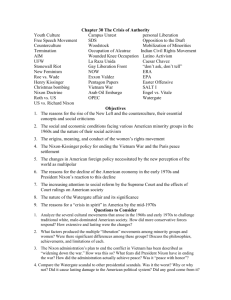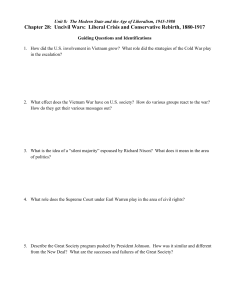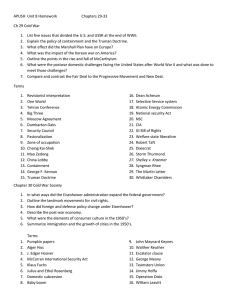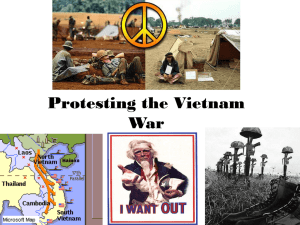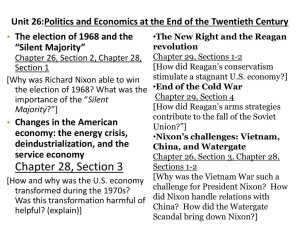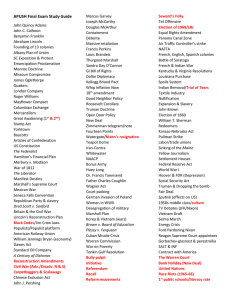Nixon Years - Rosholt School District
advertisement
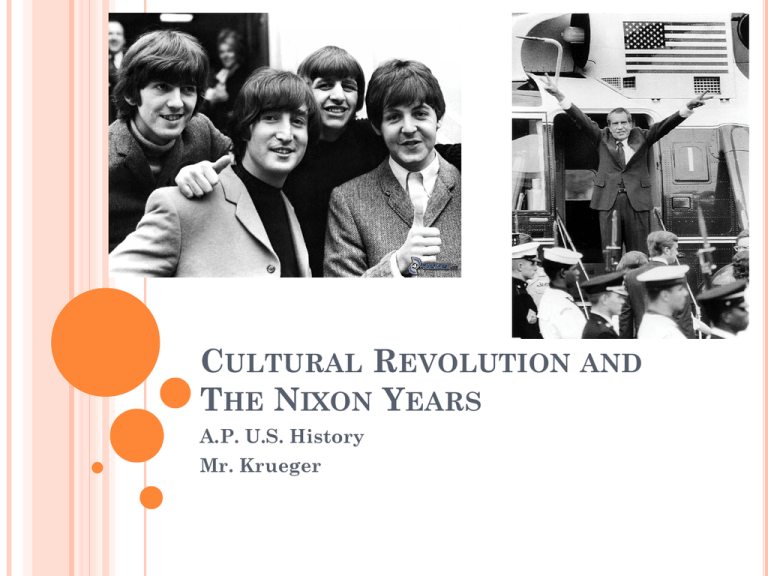
CULTURAL REVOLUTION AND THE NIXON YEARS A.P. U.S. History Mr. Krueger COUNTER CULTURE SDS – Students for a democratic society Met in Port Huron under the leadership of Al Haber and Tom Hayden Goal – transform their student protest group into a vehicle to rid society of poverty, racism and violence ½ of society was under the age of 30 and ready for the counter culture. Social Change through democracy, Salvation through individualism. SDS spurred on by the Vietnam War, grew by the thousands Older Americans felt the traditional values and ethics were under attack by the youth Drug experimentations Sex Rock and Roll REBELS The 1st sign of student rebellion (1964) – University of California at Berkeley Student free speech movement – occupied an administration building – block arrest of non student protester The cause of campus unrest was the older generations view of affluence as the answer to problems Higher education was a servant of corporate culture Trained many technicians, harbored research labs which perfected dangerous weapons, regulated students with IBM punch cards Students addressed three evils: Racism Poverty War LBJ TORMENT The cause went from Civil Rights to Vietnam Began at the University of Michigan 1965 and spread 20,000 protesters gathered at D.C. to anti-war songs One of the greatest ironies in Vietnam were the draft deferments Those in college could avoid the draft – upper class could avoid war. African Americans and Hispanic Americans most likely to be drafted. Protests increased with escalation “Hey, hey LBJ, how many kids have you killed today?” 1967 100,000 demonstrators gather outside the Pentagon Climax in spring of 1968 – SDS and African Americans seized buildings and paralyzed Colombia University (NY) Students failed to stop the war, but gained a voice in education and transformed American morals and culture CULTURAL REVOLUTION The cultural rebellion by youth in the 60’s was pervasive and led by college students that challenged adult values on: Clothing, Hairstyles, Sexual Conduct, Work Habits, Music Families gave way for communes for flower children Music was infused with social protest Beatles and Grateful Dead Woodstock (Bethel, NY)– 3 day festival of rock, drugs, and public sexual activity Former Harvard Univ. Prof. Tim Leary encouraged drug experimentation for youth “Tune in, turn on, drop out.” Marijuana and LSD Hippie movement was led by Jerry Rubin and Abbie Hoffman – capitalized on the mood of social protest BLACK POWER Wanted economic equality in the north Riots in the mid to late 60’s A change was observed when black militants took over leadership – SNCC leader Stokely Carmichael reversed MLKs nonviolent approach – promoted that southern whites should seize power while they had numbers Other leaders H. Rap Brown – said to gather guns and burn the town of Cambridge, Maryland Huey Newton – Black Panther Leader “Political Power comes through the barrel of a gun.” MLK suffered most from this approach – alienated by the NAACP Before King could lead his Poor March on Washington – he was assassinated Led to an outbreak of riots in 125 cities – worst was in D.C. Positive side – leaders urged blacks to take pride in heritage Afro Hairstyles, Dress in dashikis, Stress African Roots, Black Student programs “Negro” term disappeared and was replaced by “black” and “African American” James Brown: Say it loud, I’m black and I’m proud DISCUSSION What were other ethnic groups and women doing? What was a woman’s role in the home? How did the Feminine Mystique challenge this? Who are: Betty Freidan Ti-Grace Atkinson Susan Brownmiller THE RETURN OF RICHARD NIXON Democratic Divide: Kennedy was assassinated by Sirhan Sirhan Chicago Democratic Convention marred by violence – Humphrey gains the ticket Nixon runs for the Republicans with Spiro T. Agnew Wide lead because of discontent with the war Promised to bring a divided nation back together Humphrey was hounded by antiwar demonstrators Eugene McCarthy (MN) Robert Kennedy (NY) Hubert Humphrey (VP) George Wallace further splits the Democrats “Segregation now, Segregation tomorrow, Segregation Forever!” runs for president. Would come in 3rd at the polls. Nixon won by the smallest share of the popular vote since 1916. Clear win with the electoral vote. The combined popular vote of Nixon and Wallace showed people were fed up with violence Concerns over drugs, rock, sex and long hair led to a Republican President PRESIDENT NIXON Seemed to be a new Nixon – restrained and moderate, but underneath he remained bitter, hurt, and sensitive. Was shy, wanted to enjoy the power in solitude Assembled a powerful staff – purpose was to isolate RN from Congress, his cabinet, and the press He turned Domestic Policy over to H.R. Haldeman and John Ehrlichman. Foreign Policy was RN specialty. Relied on Henry Kissinger (Nat. Sec. Advisor) The RN Whitehouse was like a fortress under siege, and RN cut himself from the public and set up his own downfall NIXON’S PROMISES RN was successful in shifting social problems to state and local governments. Introduced revenue sharing. Congress approved Decided to shift Civil Rights to the court system – led to the termination of segregated schools. Puts blame on the courts in the south, not RN. Appointed moderates to the courts which upheld the legality of desegregation. Supreme Court moderation and the legislature record of RN indicated the nation was not ready to abandon 1960’s reforms Change in Civil Rights slowed Commitment to social justice was clear Nixonomics His challenge was the economy – inherited LBJ growing inflation. LBJ waged the Vietnam War without increasing taxes. Nixon wanted to decrease government spending and raise interest tax Result – disaster! Inflation increased, economy went into recession, unemployment rose, businesses failed. Solution – 90 freeze on prices and wages, devaluation of the dollar along with a 10% surtax on imports to balance trade. NIXON’S POLITICS RN unleashed Agnew on social issues – he blamed drugs, sex, and crime on Democratic Liberals. Democrats struck back – blamed republicans for inflation and recession Democrats join with others against crime, drugs, and pornography RN top priority was foreign policy Grand Plan – saw Vietnam War problems, and Soviet arms buildup Solution – U.S. trade(grain, high tech.) to induce Soviet cooperation and improve Chinese relations They used China to reach détente with the Soviets 1972 – RN tours China and Moscow Establishes American Liaisons in Beijing Creates SALT: Strategic Arms Limitation Talks – 1st step towards nuclear arms control ENDING VIETNAM WAR RN could not solve the problems in Vietnam. Created a 3 part plan: Renewed Bombing Hard-line negotiations against Hanoi Gradual Withdrawal The plan involved Vietnaminization – train S. Vietnam to gradually take over. 1964 – 543,000 troops 1972 – less than 30,000 Renewed Bombing was the most controversial part of the plan – strikes in Cambodia caused major campus protests. Protests broke out in over 400 campuses Kent state fire bombings – 4 students killed, 11 wounded by National Guard. Riots at Jackson State – 2 African American students killed. RN called the protesters “bums” who wanted to blow up the campus. Polls taken blame students. NEGOTIATIONS WITH HANOI 3rd tactic proved successful Kissinger held secret meetings in N. Vietnam 1972 – both sides near an agreement – then S. Vietnam blocked a settlement When Hanoi tried to make changes, RN ordered B-52 bombing raids on the capital – this brought a truce – the Paris Peace Accords (1973) In return for the release of U.S. prisoners, the U.S. would leave S. Vietnam in 60 days. Leads to the fall of Saigon – N. Vietnam could keep troops in S. Vietnam After 8 years, the U.S. abandons SE Asia. NIXON…CORRUPT…? RN’s distrust led to a series of underhanded and illegal activities. Ordered bombings of Cambodia without consent of Congress Paris Peace Accords never ratified by the U.S. Senate Placed wiretaps on the phones of reporters and staff members J. Edgar Hoover guarded against rivals by blocking a scheme of a White House aide to engage in extensive electronic eavesdropping and burglary The NY Times and Washington Post began to publish the Pentagon Papers (classified defense dept. documents on the Vietnam War) RN took drastic measures to stop leaks – created the “plumbers” G. Gordon Liddy and E. Howard Hunt were the directors – preserve secrecy, discredit those who kept the press informed Created and “enemy list” of prominent Americans Went to extreme lengths to be re-elected CREEP – Committee to re-elected the President Plan to spy on the competition and bug the Democratic National Headquarters in the Watergate Complex June 17 – James McCord and 4 others were caught by police during a break in at the Watergate AFTERMATH Due to republican dirty tricks the democrats self-destruct Edmund Muskie lost composure George Wallace was shot and paralyzed by Arthur Bremer George McGovern emerged as the democratic Nominee Democratic Platform – extremist Negotiated Settlement in Vietnam Right to Abortion Tolerance for different lifestyle RN let extremist view become the campaign issue – won by a landslide victory and 60.8% of the popular vote Democrats controlled congress, but GOP made gains in the Sunbelt WATERGATE Did Nixon know? What happened? Cover-up? Who was involved? What brought RN down? What ended Watergate? U.S. ECONOMY Cheap oil was key after WWII for U.S. expansion October War – Egypt and Syria attack Israel U.S. as mediator and supporter of Israel. OPEC announced a cut in oil production until Israel surrendered the acquired land. Cut U.S. off from oil. RN closed gas stations on the weekends, 50mph cap on speed limits, lowering of thermostats. Kissinger negotiated a deal in the ME – but proves U.S. needs other countries. Oil Crisis continues under Ford FORD What was he like, how did he get into office? Nixon? Oil Crisis? Tax Cuts? Economy/inflation problems, Energy Policy? What was his relationship to the CIA? CARTER What was he like? Economic recovery? Energy Policy? Inflation problems? Camp David Accords? Trouble with Iran? Ayatollah Khomeini Hostage Crisis REAGAN BUSH SR. CLINTON BUSH JR. OBAMA
